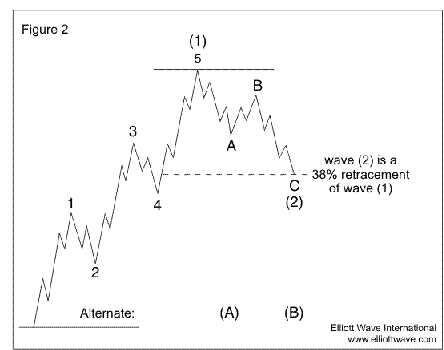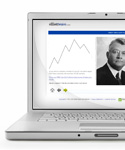Trading with Elliott wave analysis - GPS vs. Road Map: Which Works Best? (Part 2)
InvestorEducation / Elliott Wave Theory Dec 22, 2015 - 07:45 PM GMTBy: EWI
 (Continued; here is part one of this article, if you missed it.)
(Continued; here is part one of this article, if you missed it.)
Think of Trading and Investing as a Trip
Here's my advice: View the Elliott Wave Principle as your road map to the market -- and your investment idea as a trip.
You start the trip with a specific plan in mind, but conditions along the way may force you to alter course. As I mentioned earlier, alternate Elliott wave counts are simply side roads that sometimes end up being the best path.
Elliott's highly specific rules keep the number of valid wave-pattern interpretations to a minimum. Usually, you would consider the "preferred count" to be the one that satisfies all three of Elliott's rules and the largest number of guidelines. Your top "alternate" is the one that satisfies the next largest number of guidelines, and so on.
There are only three hard-and-fast rules with the Wave Principle:
- Wave 2 cannot retrace more than 100% of wave 1
- Wave 4 does not end within the price territory of wave 1 (one infrequent exception: highly leveraged markets)
- Wave 3 is never the shortest wave of a 5-wave impulse
These three rules give you specific "make-or-break" levels for any given wave patern interpretation. In Figure 2, for example, if the move labeled (2) continues below the level of the beginning of wave (1), then the originally preferred interpretation would be instantly invalidated. You would know it's not a "1-2," in other words.
The three rules help you eliminate subjectivity, firm up your investment strategy -- and reduce your risk.
"Are We There Yet?"
You've probably heard this irritating question from the back seat just about a million times.
Every map has a scale which helps you determine how many miles I have to travel before I reach my destination. When using the Wave Principle, Fibonacci relationships are your scale.
Many investors today know that Fibonacci ratios are used for market forecasting. But few realize that Fibonacci analysis of the markets was pioneered by R.N. Elliott. The use of Fibonacci ratios requires a valid Elliott wave interpretation as a starting point. Unfortunately, many non-Elliott analysts try to find Fibonacci proportions between market moves that are not related to each other in any way. This has made the approach appear to be far less valuable than it is.
Elliott wave analysis has two chief insights concerning Fibonacci relationships within waves.
First, corrective waves tend to retrace prior impulse waves in a Fibonacci proportion. For example, wave (2) in Figure 2 retraces 38% of wave (1). That's a common relationship. Other frequent retracement points for second waves are 50% and 62%.
Second, impulse waves tend to be related to one another in Fibonacci proportion. For example, wave 3 usually travels at least 1.62 times the distance traveled by wave 1. When you see wave 3 achieve that length, you can also expect wave five to be equal in length to wave one.
Knowing these simple and common ratios between waves helps you with "Are we there yet" questions.
Planning the Trip
Just as I sit down and plan my trips, I rely on wave interpretations and Fibonacci relationships to help establish investment strategies and reduce risk exposure when I analyze the markets. If you subscribe to my Currency Pro Service or any other of our publications, you use these same wave analysis methods to help decide where to get into a market, where to get out and at what point to give up on a strategy.
The Wave Principle lets you identify the highest probability direction for the market. It also lets you adopt an optimum position to take advantage of the expected move -- all while protecting yourself against lower probability outcomes.
You couldn't ask more from your own GPS.
(Editor's note: Here's a 3-min. clip from one of Jim's videos explaining which waves offer the best trading opportunities.)
|
If you are prepared to take the next step in educating yourself about the basics of the Wave Principle -- access the FREE Online Tutorial from Elliott Wave International. The Elliott Wave Basic Tutorial is a 10-lesson comprehensive online course with the same content you'd receive in a formal training class -- but you can learn at your own pace and review the material as many times as you like! Get 10 FREE Lessons on The Elliott Wave Principle that Will Change the Way You Invest Forever >> |
This article was syndicated by Elliott Wave International and was originally published under the headline GPS vs. Road Map: Which Works Best? (Part 2). EWI is the world's largest market forecasting firm. Its staff of full-time analysts led by Chartered Market Technician Robert Prechter provides 24-hour-a-day market analysis to institutional and private investors around the world.
Sincerely,
About the Publisher, Elliott Wave International
Founded in 1979 by Robert R. Prechter Jr., Elliott Wave International (EWI) is the world's largest market forecasting firm. Its staff of full-time analysts provides 24-hour-a-day market analysis to institutional and private investors around the world.
© 2005-2022 http://www.MarketOracle.co.uk - The Market Oracle is a FREE Daily Financial Markets Analysis & Forecasting online publication.





